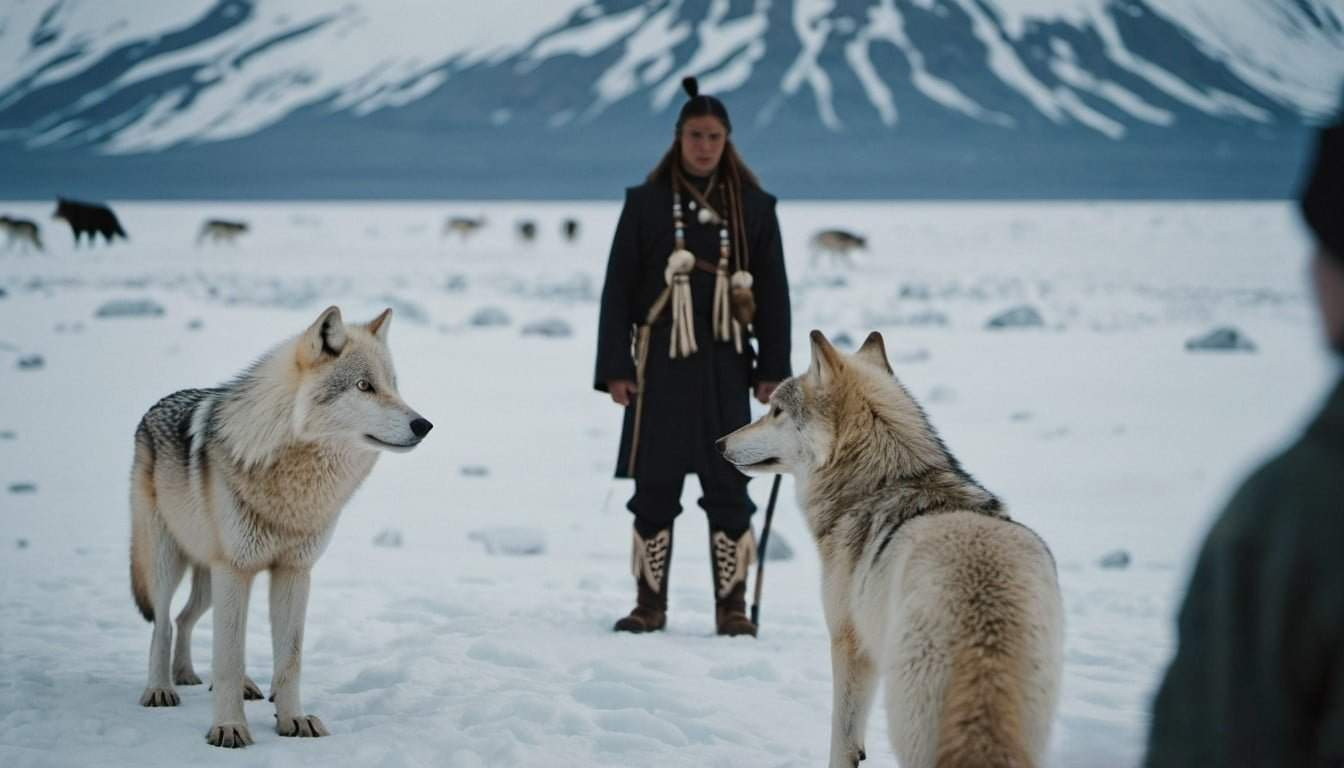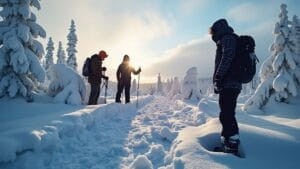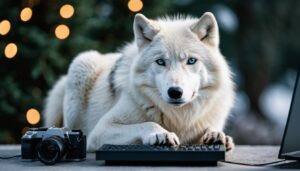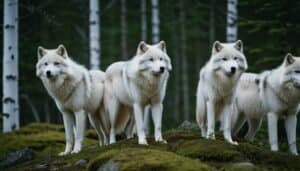Introduction
The presence of Arctic wolves has significantly influenced the cultural heritage of indigenous peoples
This article will explore various aspects of this influence, including the depiction of Arctic wolves in folklore, their spiritual significance, traditional practices involving these animals, and their representation in indigenous art
Additionally, we will examine how the relationship between Arctic wolves and indigenous communities has evolved over time
Cultural Significance of Arctic Wolves
The Arctic wolf, a symbol of strength and resilience, holds a significant place in the cultural heritage of indigenous peoples in the Arctic region
This section delves into the various ways Arctic wolves are woven into the fabric of indigenous culture, from folklore and spirituality to their role in ceremonies
Arctic Wolves in Indigenous Folklore
Indigenous folklore is rich with stories that feature Arctic wolves as central characters. These tales often highlight the wolves’ intelligence, loyalty, and strength, portraying them as both protectors and spiritual guides
In many narratives, Arctic wolves are seen as messengers between the physical and spiritual worlds, capable of guiding souls and offering wisdom to those who listen
One common theme in these stories is the transformation of humans into wolves and vice versa, symbolizing the deep connection between humans and nature. For example, some tales recount how ancestors could shape-shift into wolves to navigate the harsh Arctic environment more effectively, illustrating the blend of human ingenuity and the natural prowess of the wolf
Specific Stories Featuring Arctic Wolves
Among the numerous tales, a well-known story is that of the “Wolf Woman,” a mythical figure who transforms into a wolf to protect her village from dangers
This story teaches lessons of bravery, sacrifice, and the importance of community. Another popular legend is “The Wolf and the Moon,” where a wolf’s howls are said to bring the moon closer to the earth, highlighting the wolf’s powerful connection to celestial bodies and natural cycles
These stories are often passed down through generations via oral traditions, ensuring that the cultural significance of Arctic wolves remains a living part of indigenous heritage
Storytelling sessions, especially during long winter nights, serve not only as entertainment but also as educational and spiritual practices that reinforce community values and knowledge about the natural world
Spiritual Significance and Role in Ceremonies
Arctic wolves hold profound spiritual significance for many indigenous groups. They are often seen as totems or spirit animals, embodying traits that are revered and aspired to within the community
The wolf’s qualities of endurance, keen instincts, and strong social bonds are particularly admired
In spiritual beliefs, Arctic wolves are thought to possess the ability to traverse both the earthly and spiritual realms. This duality makes them powerful symbols in ceremonies and rituals
For instance, during initiation rites, young members of the community might wear wolf masks or skins to invoke the wolf’s spirit, seeking guidance and strength for the challenges ahead
Symbolism in Spiritual Beliefs
The symbolism of the Arctic wolf extends into various aspects of spiritual beliefs. Wolves are often associated with the north wind, which is both a harbinger of change and a test of resilience
Their howls are believed to carry prayers to the spirits, acting as intermediaries between the human and spiritual worlds
In some traditions, the appearance of a wolf in dreams is considered a powerful omen, signaling a period of transformation or the need for introspection. The wolf’s ability to navigate the harsh Arctic landscape mirrors the spiritual journey of individuals seeking clarity and purpose
Overall, the Arctic wolf’s presence in folklore, spirituality, and ceremonies underscores its integral role in the cultural fabric of indigenous peoples. These elements not only highlight the deep respect and admiration for the Arctic wolf but also reflect the broader themes of interconnectedness and harmony with nature that are central to indigenous worldviews
Practical Interactions with Arctic Wolves
The relationship between indigenous peoples and Arctic wolves extends beyond spiritual and cultural symbolism. It encompasses practical interactions that have historically been crucial for survival in the harsh Arctic environment
This section explores how Arctic wolves influence traditional practices, hunting techniques, and daily survival skills among indigenous communities
Traditional Practices Involving Arctic Wolves
Arctic wolves play an integral role in the traditional practices of indigenous peoples, who have learned to coexist with these animals through a deep understanding of their behavior and ecology
This knowledge has been passed down through generations, ensuring that indigenous communities can sustainably interact with the wolves and the broader environment
One of the most notable practices is the respectful observation and imitation of wolf hunting strategies. Indigenous hunters have long studied wolf pack behavior to enhance their own hunting techniques. Wolves are expert hunters, often working in coordinated packs to take down prey much larger than themselves
By observing these methods, indigenous hunters have developed cooperative hunting strategies that increase their chances of success in capturing game such as caribou and seals
Hunting Techniques
The hunting techniques of Arctic wolves have directly influenced the hunting practices of indigenous peoples. For example, wolves are known for their endurance and ability to track prey over long distances
Indigenous hunters, inspired by this endurance, have honed their skills in tracking and persistence hunting, which involves following prey until it is exhausted
Another technique borrowed from wolves is the use of decoys and strategic positioning. Wolves often use members of the pack to distract or corral prey into ambushes. Similarly, indigenous hunters might use decoys or coordinate in groups to guide animals into traps or towards hunters positioned for a successful strike
Additionally, wolves’ acute senses of smell and hearing are emulated by hunters who train themselves to be highly observant and attuned to their surroundings. This heightened awareness is critical for detecting prey and potential dangers in the Arctic wilderness
Daily Life and Survival Skills
Beyond hunting, Arctic wolves have influenced various aspects of daily life and survival skills among indigenous communities. For instance, the wolves’ ability to navigate the Arctic landscape has inspired indigenous people to develop advanced techniques for travel and orientation
Just as wolves use landmarks and environmental cues to find their way, indigenous travelers rely on natural markers, weather patterns, and celestial navigation to traverse the vast Arctic expanse
Wolves are also known for their social structure and cooperative living, which mirror the communal values of indigenous societies. The importance of strong family bonds and teamwork is reflected in both wolf packs and human communities
Indigenous peoples often emphasize these principles, fostering a sense of unity and mutual support that is essential for survival in challenging environments
Moreover, Arctic wolves’ adaptations to extreme cold have informed indigenous knowledge of clothing and shelter. The thick fur of wolves, which provides insulation against freezing temperatures, has influenced the design of traditional garments made from animal hides and furs
Similarly, the construction of shelters that mimic the natural dens of wolves helps to ensure warmth and protection from the elements
In terms of diet, observing the feeding habits of wolves has provided insights into the nutritional value of various Arctic species. Indigenous diets often include the same prey animals hunted by wolves, such as caribou, seals, and fish
This shared diet underscores the interconnectedness of the Arctic ecosystem and the role of wolves as both competitors and partners in survival
Artistic Representations of Arctic Wolves
The cultural significance of Arctic wolves is vividly expressed through various forms of indigenous art
This section examines how these majestic animals are portrayed in both visual and performing arts, reflecting the deep reverence and symbolic importance they hold in indigenous cultures
Visual Arts
Arctic wolves frequently appear in the visual arts of indigenous peoples, with their images often imbued with spiritual and cultural meaning. These representations can be found in various mediums, including carvings, paintings, textiles, and beadwork:
Carvings and Sculptures
One of the most prominent forms of visual art is carving. Indigenous artists often use materials such as bone, ivory, and stone to create intricate sculptures of Arctic wolves
These carvings capture the essence of the wolves, showcasing their powerful forms and expressive features. Often, these pieces are not merely decorative but are imbued with symbolic meanings, representing traits such as strength, loyalty, and guidance
Paintings and Drawings
Paintings and drawings of Arctic wolves are also common, with artists depicting these animals in various scenes that highlight their role in the natural world and their interactions with humans
These artworks often feature vivid colors and intricate details, bringing to life the stories and legends that surround the wolves. The imagery might depict wolves in hunting scenes, howling at the moon, or interacting with indigenous people, illustrating the close relationship between the two
Textiles and Beadwork
In textiles, Arctic wolves are often depicted through intricate beadwork and embroidery. These designs are typically incorporated into clothing, blankets, and ceremonial items, serving both decorative and symbolic purposes
The meticulous craftsmanship involved in these works reflects the high regard in which Arctic wolves are held and the importance of their representation in everyday and ceremonial life
Performing Arts
Arctic wolves also play a significant role in the performing arts, particularly in traditional dances and storytelling. These performances are not only forms of entertainment but also vital methods of preserving and transmitting cultural heritage:
Traditional Dances
In many indigenous cultures, dances that mimic the movements and behaviors of Arctic wolves are performed during special ceremonies and gatherings
Dancers might wear wolf masks or costumes to embody the spirit of the wolf, moving in ways that reflect the animal’s grace, power, and agility. These dances are often accompanied by traditional music and chants, creating a powerful and immersive experience that honors the wolf and its significance to the community
Storytelling
Storytelling is a cornerstone of indigenous cultural expression, and Arctic wolves are frequently central characters in these narratives
Storytellers, who are often respected elders, recount tales that have been passed down through generations, using expressive language and gestures to bring the stories to life. These stories might explain natural phenomena, teach moral lessons, or recount historical events, with Arctic wolves serving as symbols of various virtues and ideals
Theater and Performance
In addition to traditional forms of storytelling, some indigenous communities have adapted modern theatrical techniques to create performances that explore themes related to Arctic wolves
These productions might include elements of drama, dance, and multimedia, providing a contemporary platform for expressing cultural narratives and exploring the ongoing relationship between humans and wolves
Evolution of the Relationship
The relationship between Arctic wolves and indigenous peoples is dynamic and has evolved significantly over time
This section delves into the historical perspectives and modern-day interactions, illustrating how the connection between these two has adapted to changing environments and societal developments
Historical Perspectives
Historically, the relationship between indigenous peoples and Arctic wolves has been characterized by mutual respect and understanding
For centuries, indigenous communities have observed and learned from wolves, integrating these insights into their cultural practices and survival strategies:
Early Coexistence
In the early days, indigenous peoples and Arctic wolves coexisted in a delicate balance. Both groups hunted the same prey and navigated the same harsh landscapes, leading to a mutual understanding and respect
Indigenous hunters observed wolves to learn effective hunting techniques and adapt their strategies accordingly. This observation was not merely practical but also spiritual, as wolves were seen as teachers and guides in the natural world
Cultural Integration
As indigenous cultures developed, the wolf became an integral part of their folklore, spiritual beliefs, and daily practices
The integration of the wolf into various cultural aspects underscored the deep connection between the two. Wolves were often depicted in stories as wise and powerful beings, embodying traits that were highly valued within the community
Changes Due to External Influences
With the arrival of European settlers and the subsequent changes in the Arctic landscape, the relationship between indigenous peoples and Arctic wolves began to shift. External influences such as hunting regulations, habitat destruction, and changes in prey populations affected both human and wolf populations
Despite these challenges, indigenous communities continued to maintain their cultural connections to the wolves, adapting their practices and beliefs to the changing circumstances
Modern-Day Interactions
In contemporary times, the relationship between indigenous peoples and Arctic wolves continues to evolve, reflecting both the resilience of indigenous cultures and the ongoing changes in the Arctic environment:
Conservation Efforts
Today, many indigenous communities are at the forefront of conservation efforts aimed at protecting Arctic wolves and their habitats. These efforts are often grounded in traditional ecological knowledge, which emphasizes the importance of maintaining balance within the ecosystem
Indigenous-led conservation initiatives work to ensure that wolf populations remain healthy and that their habitats are preserved for future generations
Cultural Revitalization
There has also been a resurgence of interest in traditional cultural practices and beliefs, including those related to Arctic wolves
Indigenous communities are actively working to revitalize their languages, stories, and ceremonies, ensuring that the cultural significance of the wolf is passed down to younger generations
This cultural revitalization is often supported by educational programs, cultural events, and community gatherings that celebrate the unique heritage of indigenous peoples
Collaborative Research
Collaborative research projects involving indigenous knowledge holders and scientists are becoming more common. These projects aim to combine traditional knowledge with scientific methods to better understand Arctic wolf behavior, ecology, and the broader Arctic environment
Such collaborations recognize the value of indigenous perspectives and seek to integrate them into broader conservation and research efforts
Tourism and Economic Opportunities
The growing interest in Arctic tourism presents both opportunities and challenges for indigenous communities. On one hand, tourism can provide economic benefits and opportunities to share cultural knowledge with a wider audience
On the other hand, it can also pose risks to the delicate balance between humans and wildlife. Indigenous communities are working to develop sustainable tourism practices that respect the natural environment and cultural heritage while providing meaningful experiences for visitors
Challenges and Adaptations
Modern-day interactions between indigenous peoples and Arctic wolves are also shaped by contemporary challenges such as climate change, industrial development, and shifting wildlife patterns
Indigenous communities are actively adapting to these changes, using their traditional knowledge and resilience to navigate the evolving landscape
This ongoing adaptation highlights the enduring connection between indigenous peoples and Arctic wolves, as both continue to find ways to thrive in the Arctic environment
Conclusion
The presence of Arctic wolves has a profound influence on the cultural heritage of indigenous peoples, reflecting a deep, multifaceted relationship that spans folklore, spiritual beliefs, traditional practices, artistic expression, and practical interactions
In the realm of folklore, Arctic wolves appear in countless stories and legends, serving as symbols of strength, wisdom, and resilience. These narratives not only entertain but also educate, passing down valuable lessons and cultural values through generations
Spiritually, wolves are revered as powerful totems and guides, playing significant roles in ceremonies and embodying traits that are deeply respected within indigenous communities
Practically, the relationship with Arctic wolves extends to daily survival and traditional practices. Indigenous hunters have long studied and emulated wolf hunting techniques, improving their own methods and ensuring sustainable practices
The influence of wolves is also evident in daily life, from navigation and survival skills to social structures that mirror the cooperative living seen in wolf packs
Artistically, Arctic wolves are celebrated through visual arts, such as carvings, paintings, and textiles, as well as performing arts, including traditional dances and storytelling. These artistic representations serve as a testament to the cultural importance of wolves and the rich heritage of indigenous peoples
Over time, the relationship between Arctic wolves and indigenous peoples has evolved, adapting to external influences and modern challenges. Historical perspectives highlight a balanced coexistence and deep integration of wolves into cultural practices
In contemporary times, this relationship continues to grow through conservation efforts, cultural revitalization, collaborative research, and sustainable tourism, all while facing the challenges of climate change and industrial development
In essence, the bond between Arctic wolves and indigenous peoples is a dynamic and enduring one, characterized by mutual respect, adaptation, and a shared journey through the Arctic’s harsh and beautiful landscape
This relationship not only enriches the cultural heritage of indigenous communities but also underscores the importance of preserving the natural world and the wisdom it holds










